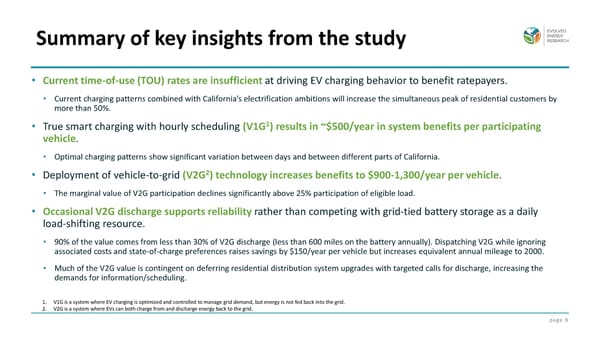page 8 • Current time-of-use (TOU) rates are insufficient at driving EV charging behavior to benefit ratepayers. • Current charging patterns combined with California’s electrification ambitions will increase the simultaneous peak of residential customers by more than 50%. • True smart charging with hourly scheduling (V1G1) results in ~$500/year in system benefits per participating vehicle. • Optimal charging patterns show significant variation between days and between different parts of California. • Deployment of vehicle-to-grid (V2G2) technology increases benefits to $900-1,300/year per vehicle. • The marginal value of V2G participation declines significantly above 25% participation of eligible load. • Occasional V2G discharge supports reliability rather than competing with grid-tied battery storage as a daily load-shifting resource. • 90% of the value comes from less than 30% of V2G discharge (less than 600 miles on the battery annually). Dispatching V2G while ignoring associated costs and state-of-charge preferences raises savings by $150/year per vehicle but increases equivalent annual mileage to 2000. • Much of the V2G value is contingent on deferring residential distribution system upgrades with targeted calls for discharge, increasing the demands for information/scheduling. Summary of key insights from the study 1. V1G is a system where EV charging is optimized and controlled to manage grid demand, but energy is not fed back into the grid. 2. V2G is a system where EVs can both charge from and discharge energy back to the grid.
 Exploring the Value of Vehicle to Grid (V2G) for California Page 7 Page 9
Exploring the Value of Vehicle to Grid (V2G) for California Page 7 Page 9